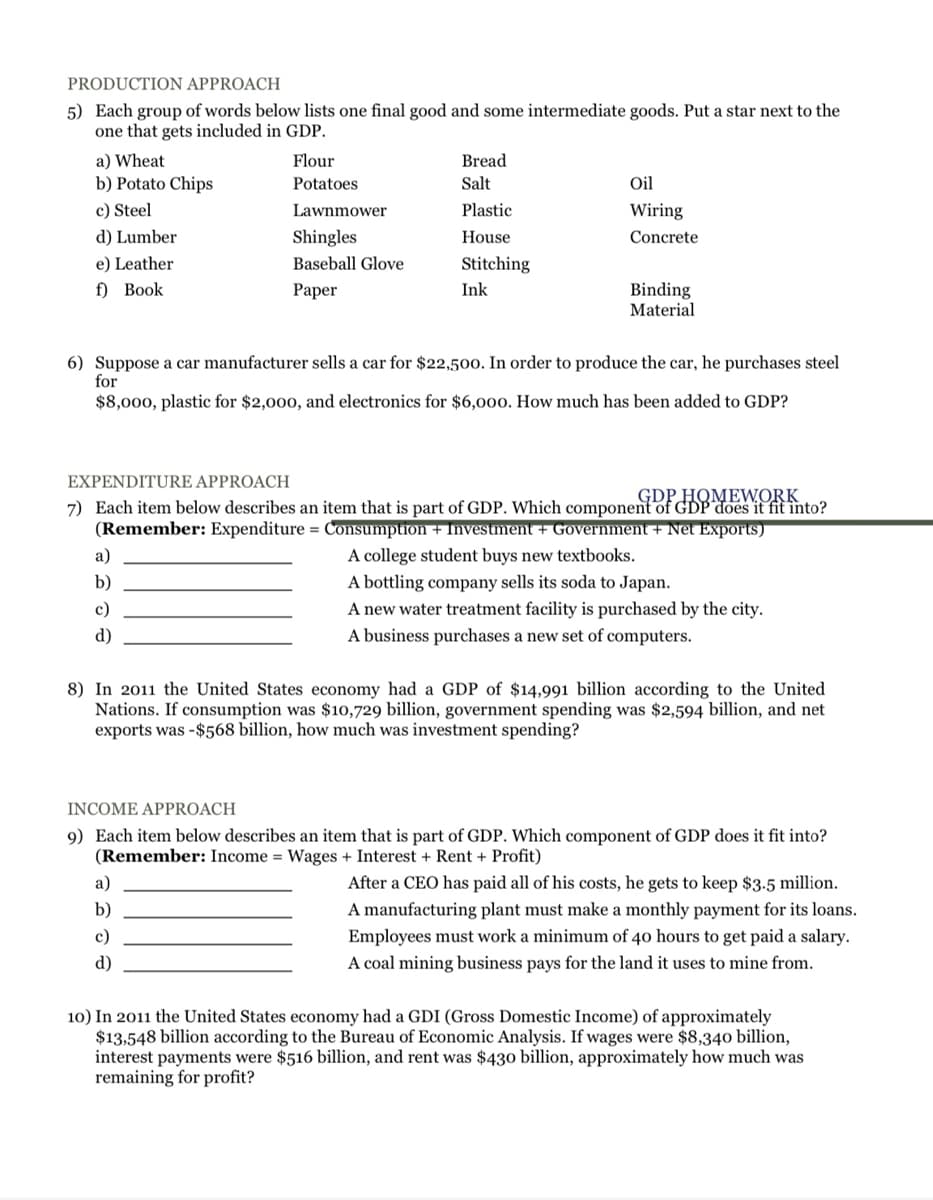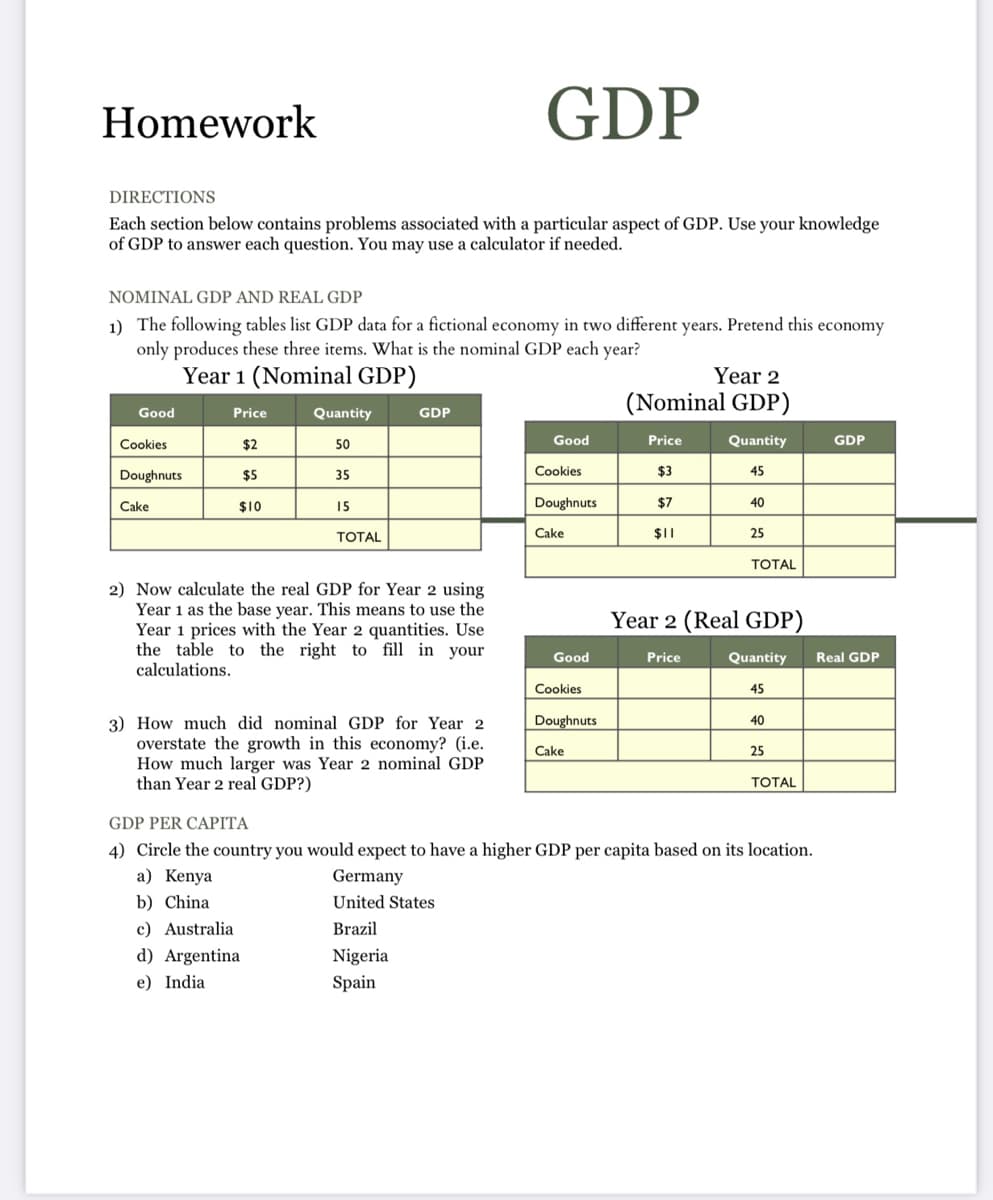PRODUCTION APPROACH 5) Each group of words below lists one final good and some intermediate goods. Put a star next to the one that gets included in GDP. a) Wheat Flour Bread b) Potato Chips Potatoes Salt Oil c) Steel Lawnmower Plastic Wiring d) Lumber Shingles House Concrete e) Leather Baseball Glove Stitching f) Вook Ink Binding Material Paper 6) Suppose a car manufacturer sells a car for $22,500. In order to produce the car, he purchases steel for $8,000, plastic for $2,000, and electronics for $6,000. How much has been added to GDP? EXPENDITURE APPROACH GDP HOMEWORK 7) Each item below describes an item that is part of GDP. Which component of GDP does it fit into? (Remember: Expenditure = Consumption + Investment + Government + Net Exports) A college student buys new textbooks. A bottling company sells its soda to Japan. A new water treatment facility is purchased by the city. A business purchases a new set of computers. а) b) c) d) 8) In 2011 the United States economy had a GDP of $14,991 billion according to the United Nations. If consumption was $10,729 billion, government spending was $2,594 billion, and net exports was -$568 billion, how much was investment spending? INCOME APPROACH 9) Each item below describes an item that is part of GDP. Which component of GDP does it fit into? (Remember: Income = Wages + Interest + Rent + Profit) a) After a CEO has paid all of his costs, he gets to keep $3.5 million. b) A manufacturing plant must make a monthly payment for its loans. c) Employees must work a minimum of 40 hours to get paid a salary. d) A coal mining business pays for the land it uses to mine from. 10) In 2011 the United States economy had a GDI (Gross Domestic Income) of approximately $13,548 billion according to the Bureau of Economic Analysis. If wages were $8,340 billion, interest payments were $516 billion, and rent was $430 billion, approximately how much was remaining for profit? Homework GDP DIRECTIONS Each section below contains problems associated with a particular aspect of GDP. Use your knowledge of GDP to answer each question. You may use a calculator if needed. NOMINAL GDP AND REAL GDP 1) The following tables list GDP data for a fictional economy in two different years. Pretend this economy only produces these three items. What is the nominal GDP each year? Year 1 (Nominal GDP) Year 2 (Nominal GDP) Good Price Quantity GDP Cookies $2 50 Good Price Quantity GDP Doughnuts $5 35 Cookies $3 45 Cake $10 15 Doughnuts $7 40 ТОTAL Cake 25 TOTAL 2) Now calculate the real GDP for Year 2 using Year 1 as the base year. This means to use the Year 1 prices with the Year 2 quantities. Use the table to the right to fill in your calculations. Year 2 (Real GDP) Good Price Quantity Real GDP Cookies 45 Doughnuts 40 3) How much did nominal GDP for Year 2 overstate the growth in this economy? (i.e. How much larger was Year 2 nominal GDP than Year 2 real GDP?) Cake 25 ТОTAL GDP PER CAPITA 4) Circle the country you would expect to have a higher GDP per capita based on its location. a) Kenya Germany b) China United States c) Australia Brazil d) Argentina Nigeria e) India Spain
PRODUCTION APPROACH 5) Each group of words below lists one final good and some intermediate goods. Put a star next to the one that gets included in GDP. a) Wheat Flour Bread b) Potato Chips Potatoes Salt Oil c) Steel Lawnmower Plastic Wiring d) Lumber Shingles House Concrete e) Leather Baseball Glove Stitching f) Вook Ink Binding Material Paper 6) Suppose a car manufacturer sells a car for $22,500. In order to produce the car, he purchases steel for $8,000, plastic for $2,000, and electronics for $6,000. How much has been added to GDP? EXPENDITURE APPROACH GDP HOMEWORK 7) Each item below describes an item that is part of GDP. Which component of GDP does it fit into? (Remember: Expenditure = Consumption + Investment + Government + Net Exports) A college student buys new textbooks. A bottling company sells its soda to Japan. A new water treatment facility is purchased by the city. A business purchases a new set of computers. а) b) c) d) 8) In 2011 the United States economy had a GDP of $14,991 billion according to the United Nations. If consumption was $10,729 billion, government spending was $2,594 billion, and net exports was -$568 billion, how much was investment spending? INCOME APPROACH 9) Each item below describes an item that is part of GDP. Which component of GDP does it fit into? (Remember: Income = Wages + Interest + Rent + Profit) a) After a CEO has paid all of his costs, he gets to keep $3.5 million. b) A manufacturing plant must make a monthly payment for its loans. c) Employees must work a minimum of 40 hours to get paid a salary. d) A coal mining business pays for the land it uses to mine from. 10) In 2011 the United States economy had a GDI (Gross Domestic Income) of approximately $13,548 billion according to the Bureau of Economic Analysis. If wages were $8,340 billion, interest payments were $516 billion, and rent was $430 billion, approximately how much was remaining for profit? Homework GDP DIRECTIONS Each section below contains problems associated with a particular aspect of GDP. Use your knowledge of GDP to answer each question. You may use a calculator if needed. NOMINAL GDP AND REAL GDP 1) The following tables list GDP data for a fictional economy in two different years. Pretend this economy only produces these three items. What is the nominal GDP each year? Year 1 (Nominal GDP) Year 2 (Nominal GDP) Good Price Quantity GDP Cookies $2 50 Good Price Quantity GDP Doughnuts $5 35 Cookies $3 45 Cake $10 15 Doughnuts $7 40 ТОTAL Cake 25 TOTAL 2) Now calculate the real GDP for Year 2 using Year 1 as the base year. This means to use the Year 1 prices with the Year 2 quantities. Use the table to the right to fill in your calculations. Year 2 (Real GDP) Good Price Quantity Real GDP Cookies 45 Doughnuts 40 3) How much did nominal GDP for Year 2 overstate the growth in this economy? (i.e. How much larger was Year 2 nominal GDP than Year 2 real GDP?) Cake 25 ТОTAL GDP PER CAPITA 4) Circle the country you would expect to have a higher GDP per capita based on its location. a) Kenya Germany b) China United States c) Australia Brazil d) Argentina Nigeria e) India Spain
Brief Principles of Macroeconomics (MindTap Course List)
8th Edition
ISBN:9781337091985
Author:N. Gregory Mankiw
Publisher:N. Gregory Mankiw
Chapter5: Measuring A Nation's Income
Section: Chapter Questions
Problem 6PA
Related questions
Question

Transcribed Image Text:PRODUCTION APPROACH
5) Each group of words below lists one final good and some intermediate goods. Put a star next to the
one that gets included in GDP.
a) Wheat
Flour
Bread
b) Potato Chips
Potatoes
Salt
Oil
c) Steel
Lawnmower
Plastic
Wiring
d) Lumber
Shingles
House
Concrete
e) Leather
Baseball Glove
Stitching
f) Вook
Ink
Binding
Material
Paper
6) Suppose a car manufacturer sells a car for $22,500. In order to produce the car, he purchases steel
for
$8,000, plastic for $2,000, and electronics for $6,000. How much has been added to GDP?
EXPENDITURE APPROACH
GDP HOMEWORK
7) Each item below describes an item that is part of GDP. Which component of GDP does it fit into?
(Remember: Expenditure = Consumption + Investment + Government + Net Exports)
A college student buys new textbooks.
A bottling company sells its soda to Japan.
A new water treatment facility is purchased by the city.
A business purchases a new set of computers.
а)
b)
c)
d)
8) In 2011 the United States economy had a GDP of $14,991 billion according to the United
Nations. If consumption was $10,729 billion, government spending was $2,594 billion, and net
exports was -$568 billion, how much was investment spending?
INCOME APPROACH
9) Each item below describes an item that is part of GDP. Which component of GDP does it fit into?
(Remember: Income = Wages + Interest + Rent + Profit)
a)
After a CEO has paid all of his costs, he gets to keep $3.5 million.
b)
A manufacturing plant must make a monthly payment for its loans.
c)
Employees must work a minimum of 40 hours to get paid a salary.
d)
A coal mining business pays for the land it uses to mine from.
10) In 2011 the United States economy had a GDI (Gross Domestic Income) of approximately
$13,548 billion according to the Bureau of Economic Analysis. If wages were $8,340 billion,
interest payments were $516 billion, and rent was $430 billion, approximately how much was
remaining for profit?

Transcribed Image Text:Homework
GDP
DIRECTIONS
Each section below contains problems associated with a particular aspect of GDP. Use your knowledge
of GDP to answer each question. You may use a calculator if needed.
NOMINAL GDP AND REAL GDP
1) The following tables list GDP data for a fictional economy in two different years. Pretend this economy
only produces these three items. What is the nominal GDP each year?
Year 1 (Nominal GDP)
Year 2
(Nominal GDP)
Good
Price
Quantity
GDP
Cookies
$2
50
Good
Price
Quantity
GDP
Doughnuts
$5
35
Cookies
$3
45
Cake
$10
15
Doughnuts
$7
40
ТОTAL
Cake
25
TOTAL
2) Now calculate the real GDP for Year 2 using
Year 1 as the base year. This means to use the
Year 1 prices with the Year 2 quantities. Use
the table to the right to fill in your
calculations.
Year 2 (Real GDP)
Good
Price
Quantity
Real GDP
Cookies
45
Doughnuts
40
3) How much did nominal GDP for Year 2
overstate the growth in this economy? (i.e.
How much larger was Year 2 nominal GDP
than Year 2 real GDP?)
Cake
25
ТОTAL
GDP PER CAPITA
4) Circle the country you would expect to have a higher GDP per capita based on its location.
a) Kenya
Germany
b) China
United States
c) Australia
Brazil
d) Argentina
Nigeria
e) India
Spain
Expert Solution
This question has been solved!
Explore an expertly crafted, step-by-step solution for a thorough understanding of key concepts.
This is a popular solution!
Trending now
This is a popular solution!
Step by step
Solved in 2 steps

Recommended textbooks for you

Brief Principles of Macroeconomics (MindTap Cours…
Economics
ISBN:
9781337091985
Author:
N. Gregory Mankiw
Publisher:
Cengage Learning

Essentials of Economics (MindTap Course List)
Economics
ISBN:
9781337091992
Author:
N. Gregory Mankiw
Publisher:
Cengage Learning

Principles of Economics 2e
Economics
ISBN:
9781947172364
Author:
Steven A. Greenlaw; David Shapiro
Publisher:
OpenStax

Brief Principles of Macroeconomics (MindTap Cours…
Economics
ISBN:
9781337091985
Author:
N. Gregory Mankiw
Publisher:
Cengage Learning

Essentials of Economics (MindTap Course List)
Economics
ISBN:
9781337091992
Author:
N. Gregory Mankiw
Publisher:
Cengage Learning

Principles of Economics 2e
Economics
ISBN:
9781947172364
Author:
Steven A. Greenlaw; David Shapiro
Publisher:
OpenStax

Exploring Economics
Economics
ISBN:
9781544336329
Author:
Robert L. Sexton
Publisher:
SAGE Publications, Inc


Economics: Private and Public Choice (MindTap Cou…
Economics
ISBN:
9781305506725
Author:
James D. Gwartney, Richard L. Stroup, Russell S. Sobel, David A. Macpherson
Publisher:
Cengage Learning